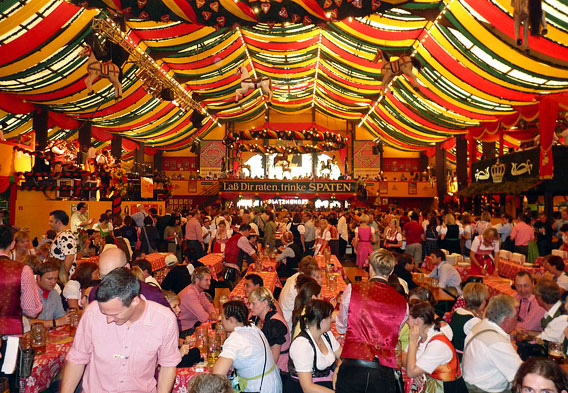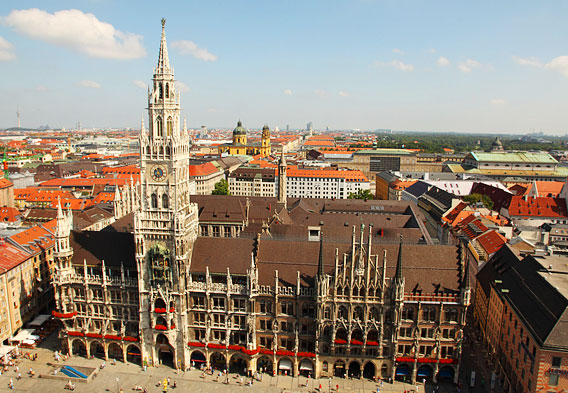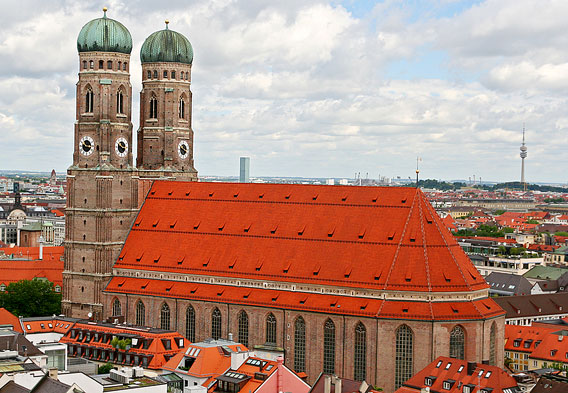| Munich Munich, capital of Bavaria, is one of the most important cities in Germany and is full of beautiful architecture. This city with a rich history is known for its gigantic Oktoberfest and such lovely areas as Marienplatz. (Read More) |
|
||||
| Tweet |

Fun Facts about Munich
Munich is the capital of the Bavaria region in Germany. This city has a long history that includes many pivotal and interesting events. Today, the city has many attractions for visitors to see and some top events worth experiencing, like the world-famous Oktoberfest here.
Munich’s long history features everything from beer to Mozart. Munich became the capital of Bavaria when it was reunited in 1506. This began a period of flowering in arts, music, and literature with such luminaries as Mozart playing a prominent role. The famous Hofbrauhaus was built in 1589 for the purpose of brewing the city’s trademark brown beer. The Kingdom of Bavaria was established in 1806, and Munich became its capital. It was during the nineteenth century that much of the city’s finest architecture was erected, and Munich began to rival Vienna as a city of beauty and culture.

Oktoberfest
Munich’s Oktoberfest is without a doubt the granddaddy of all beer festivals.
It is world famous and one of the top world festivals in any category. It is
held in Munich
during September and October, attracting more than 5 million attendees each
year. It was first held in 1810. Today, the Oktoberfest has become a veritable
Bacchanalian feast of food (including Bavarian signature foods like sausages,
potato pancakes, pretzels, sauerkraut, and red cabbage) and the consumption
of Germany’s favorite beverage—beer. About 20 to 25 large beer tents
are set up, and each of these can accommodate hundreds to several thousand revelers.
Each beer tent has its own character and type of music. You can listen to everything
from rock music to traditional “oomp pah” brass bands.

Marienplatz
Marienplatz is the center of the city. It is named, not for a person named Marien,
but for the Marien column that sits in the center of the large open square.
Here you will find both the Old (Alt) and New (Neues) Town Hall (Rathaus), which
was built in 1874 and contains 400 rooms. The Neues Rathaus tower boasts a famous
and elaborate glockenspiel that performs every day at 11 a.m., noon, and 5 p.m.
Like the Changing of the Guards at Buckingham Palace, just about every visitor
to the city will make an effort to be in the square at least once to witness
the event. Visitors can ride to the top of the tower by elevator. There are
still three medieval gates remaining from the walls and fortifications that
once surrounded the city. Other buildings and landmarks around the gracious
square include the Palace of Justice with its fountain, the Romanesque St. Peter’s
Church, the oldest (1158) church in the city, the baroque Church of the Holy
Spirit, and the Viktualienmarkt, the most popular market in the city.

The Frauenkirche
Frauenkirche,
or Church of Our Lady, is also in the city center. It is a beautiful red brick
late Gothic cathedral that is, like the New Town Hall, a symbol of Munich. There
are regulations in the area around the cathedral that limit the height of buildings.
This means the graceful towers are visible from many parts of the city. Visitors
are allowed to ascend the south tower, and there are panoramic views of the
city and all the way to the Alps.
Must See Sights
The Hellabrunn Zoo was opened in 1911. Today it is a world-class institution, and the first zoo in the world that did not segregate animals according to their species. Multiple species (more than 17,000 animals in all) live together in habitats that closely resemble their natural habitats. There are large aviaries nearly 60 feet high filled with multiple bird species, an aquarium with beautiful coral reefs and colorful fish, a jungle tent for lions and other species from Africa, an elephant enclosure and orangutan enclosure, and much more.
There are a number of lovely churches in the city, including Michaelkirche,
which is the largest Renaissance church north of the Alps, and the Italian high
baroque basilica Theatinerkirche. There are four grand avenues in the city,
reminiscent of the elegant Ringstrasse around the center of Vienna. They are
lined with wonderful buildings including the Bavarian State Library, the Maximilianeum
home of Parliament, Museum of Ethnology, State Museum of Classical Art, the
Haus der Kunst (House of Art), and the Bavarian National Museum.
Back to top © Dan Taylor/Destination360. All Rights Reserved